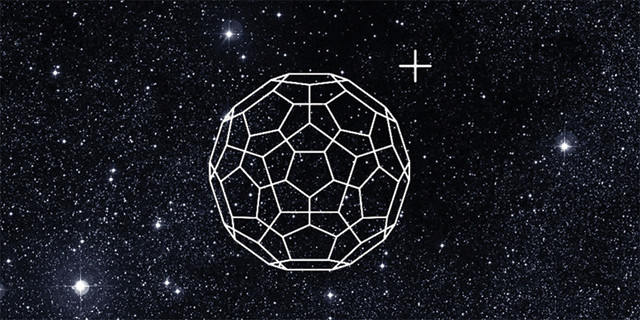
by Timothy Oleson Monday, November 2, 2015

ew research suggests interstellar ionized buckyballs absorb certain wavelengths of light coming from stars, thus obscuring those wavelengths from observers on Earth. Credit: University of Basel.
For almost a century, astronomers have observed gaps in the broad spectrum of light reaching Earth from other stars in the Milky Way galaxy. These gaps, called diffuse interstellar bands (DIBs), arise when dust and molecules in interstellar space absorb specific wavelengths of light, thus darkening those bands of light from view. Although hundreds of distinct DIBs have been recognized, scientists have only been able to hypothesize as to the identity of the molecules responsible, until now. In a new study published in Nature, scientists say they have “positively identified” one of the interstellar light-absorbers: nanometer-wide carbon cages named buckminsterfullerene, or “buckyballs.”
Composed of 60 carbon atoms each and shaped like tiny soccer balls, buckyballs were first discovered around red giant stars in 1985 and named for architect Buckminster Fuller, whose geodesic domes — although much larger — are reminiscent of the structure of complex carbon molecules. In 1994, Bernard Foing and Pascale Ehrenfreund reported two new DIBs and, based on preliminary laboratory experiments, hypothesized but could not positively confirm that the bands could arise due to absorption by ionized buckyballs floating freely in interstellar space.
For the new work, John Maier of the University of Basel in Switzerland and colleagues created an instrument that allowed them to collect the spectroscopic measurements of gaseous and ionized buckyballs necessary to confirm the earlier findings. After cooling the molecules to just 5.8 Kelvins, about the temperature they’d be at in space, Maier’s team found that the wavelengths absorbed by the buckyballs coincided with the two bands noted in 1994. In an accompanying commentary also published in Nature, Ehrenfreund and Foing called the new results “superb” and wrote that buckyballs and other DIB-causing molecules — now thought to be ubiquitous through much of space — might “constitute an important reservoir of organic material throughout the universe.”
© 2008-2021. All rights reserved. Any copying, redistribution or retransmission of any of the contents of this service without the expressed written permission of the American Geosciences Institute is expressly prohibited. Click here for all copyright requests.